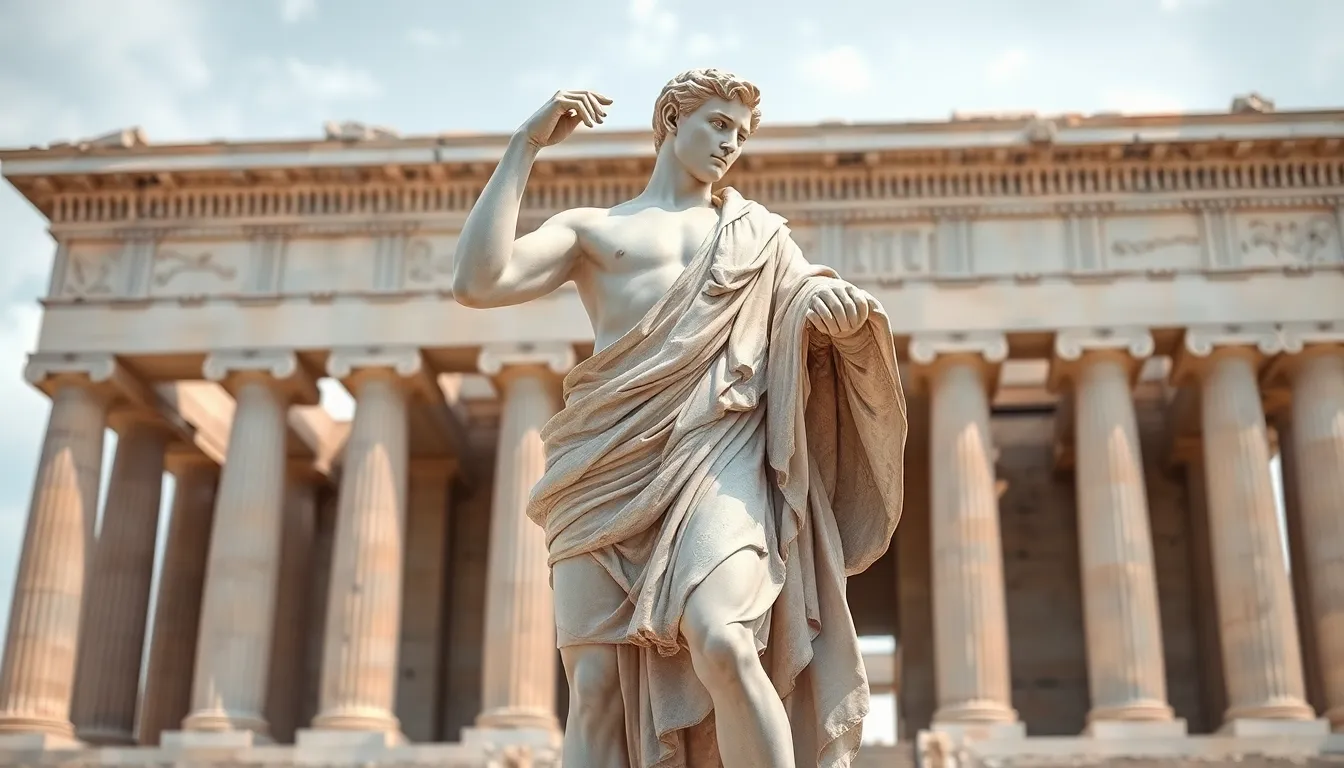Early classical Greek art isn’t just a bunch of old statues and crumbling pottery; it’s a vibrant peek into a world where creativity and innovation flourished. Imagine a time when sculptors turned mere marble into lifelike figures that could make you question if they might just step down and join the party. This artistic revolution laid the groundwork for centuries of inspiration, and it’s more than just eye candy—it’s a cultural phenomenon that shaped Western civilization.
Table of Contents
ToggleOverview of Early Classical Greek Art
Early classical Greek art marks a transformative period that emphasizes realism and human emotion in artistic expression. This era significantly influenced future artistic movements.
Key Characteristics
Sculptural works from this period exhibit idealized proportions and poses. Figures often demonstrate a naturalistic style, captured in dynamic stances. Artists focused on human anatomy, showcasing muscles and movement with precision. In addition, the use of drapery creates a sense of flow and realism in clothing. Painters also began to explore perspective, employing tricks to enhance depth and spatial awareness. These characteristics collectively contribute to a more lifelike representation of the human figure.
Historical Context
The emergence of early classical Greek art occurred after the Archaic period, amidst social and political changes in Greece. Artists sought to reflect evolving humanistic ideals as conflicts shifted societal views. The Persian Wars (490-479 BCE) instigated a newfound confidence, inspiring creativity. Major city-states like Athens played a pivotal role in fostering artistic achievements, supported by patronage from influential leaders. This artistic momentum laid the groundwork for the classical ideals that dominated Western art for centuries.
Major Artistic Developments

Early classical Greek art witnessed significant transformations in both sculpture and pottery. This period marked a departure from previous styles, showcasing innovative techniques and expressive forms.
Sculpture Innovations
Sculpture became a focal point for artistic innovation during this era. Artists perfected the representation of the human body, emphasizing realistic proportions and dynamic poses. Notable developments included the portrayal of drapery, which enhanced the illusion of movement and depth. Many sculptors, such as Phidias and Polykleitos, contributed to this evolution by exploring human anatomy in detail. Their works embodied ideals of beauty and proportion that influenced generations. The emergence of the contrapposto stance showcased a shift towards more naturalistic representations, making figures appear more lifelike.
Pottery and Vase Painting
Pottery and vase painting also thrived during early classical Greek art. Artists employed new techniques and themes that reflected daily life, mythology, and athletic competitions. Black-figure and red-figure painting styles became prominent, allowing for more intricate detail and storytelling. Artisans depicted scenes that conveyed narratives, showcasing figures in action or moments of importance. Noteworthy vases, like the Panathenaic amphora, celebrated victories in athletic contests, emphasizing the cultural significance of these events. This period laid the groundwork for the later development of ceramic styles, influencing both function and artistic expression.
Influential Artists and Works
Early classical Greek art showcases a range of influential artists and remarkable artworks that embody the era’s ideals and aesthetic innovations.
Notable Sculptors
Phidias stands out for creating monumental sculptures, including the statue of Athena Parthenos in the Parthenon, emphasizing divine beauty and grandeur. Polykleitos is renowned for his Doryphoros, a sculpture exemplifying the contrapposto stance and perfect proportions. Praxiteles contributed significantly by introducing sensuality to human forms, as seen in his famous Hermes and the Infant Dionysus. Lysippos revolutionized proportions with his updates to the human figure, evident in his Apoxyomenos, a representation of an athlete scraping oil from his body. Together, these sculptors transformed the understanding of human anatomy and emotion, setting new standards for future generations.
Important Artworks
The Kritios Boy represents a shift towards realism, showcasing the refined understanding of human posture and anatomy. Vases such as the Panathenaic amphora celebrate cultural ceremonies, captured in dynamic black-figure and red-figure painting techniques. The Discobolus, or Discus Thrower, by Myron captures athletic prowess in motion, illustrating the harmony of body and action. The Apollo Belvedere reflects the idealized male form, embodying the grace and beauty characteristic of this period. These artworks not only highlight the artistic advancements of the time but also their cultural significance in storytelling and representation.
The Impact of Early Classical Greek Art
Early Classical Greek art had profound effects on subsequent artistic developments and remains a pivotal reference point in art history.
Influence on Later Art Movements
Early Classical Greek art established foundational principles that influenced Renaissance artists like Michelangelo and Raphael. Naturalism became a standard in their works, reflecting the lifelike qualities seen in sculptures of this era. Artists adopted idealized proportions and dynamic poses, concepts pioneered by renowned sculptors such as Polykleitos. The emphasis on human emotion also resonated in Baroque and Neoclassical art, showcasing how early techniques continued to shape artistic expressions for centuries. Techniques in pottery, like red-figure painting, inspired modern ceramics, illustrating the lasting legacy of early artistic innovations.
Cultural Significance
Cultural identity in ancient Greece found expression through early Classical art, which encapsulated the values and aspirations of its society. Public sculptures and pottery depicted myths and historical events, fostering a sense of communal pride. Artistic achievements also mirrored advancements in philosophy, politics, and humanism, highlighting a newfound respect for individual beauty and form. Major festivals, such as the Panathenaic games, were illustrated on pottery, underlining the connection between art and daily life. Thus, early Classical Greek art not only celebrated aesthetics but served as a vital tool for cultural narration and identity formation.
Early classical Greek art represents a pivotal moment in the evolution of artistic expression. Its emphasis on realism and human emotion transformed not only the visual landscape of ancient Greece but also set the stage for future artistic movements. The innovations in sculpture and pottery during this era reflect a deep understanding of human anatomy and dynamic composition, showcasing the artists’ dedication to capturing the essence of life.
As a cornerstone of Western art history, early classical Greek art continues to inspire and influence artists today. Its legacy endures through the ideals of beauty and proportion that resonate in countless works across centuries. This period not only enriched the cultural fabric of Greece but also forged a lasting connection between art and the human experience.





